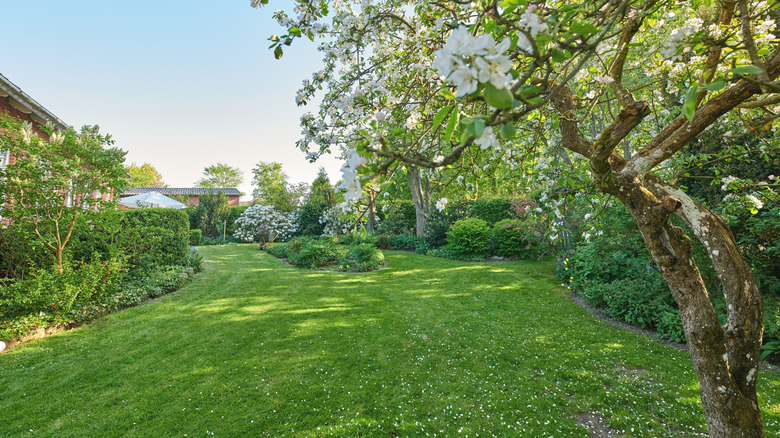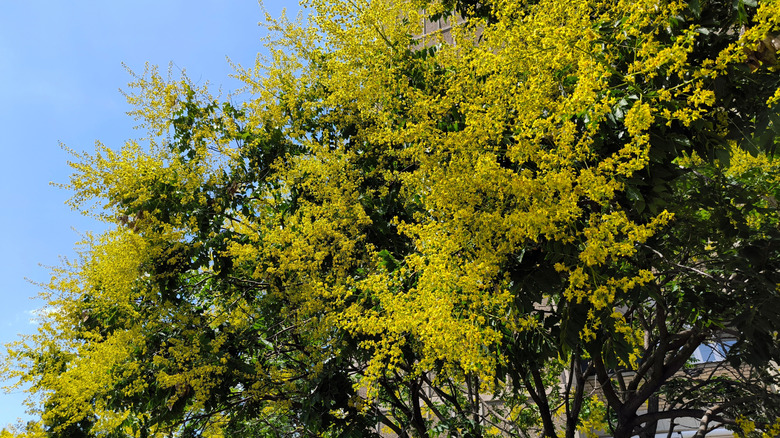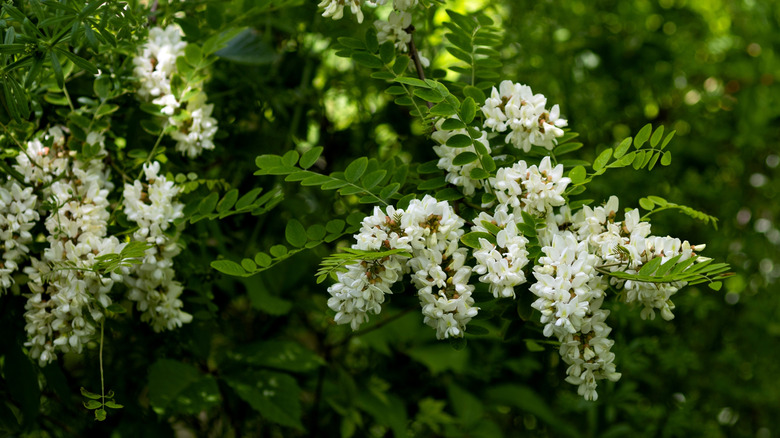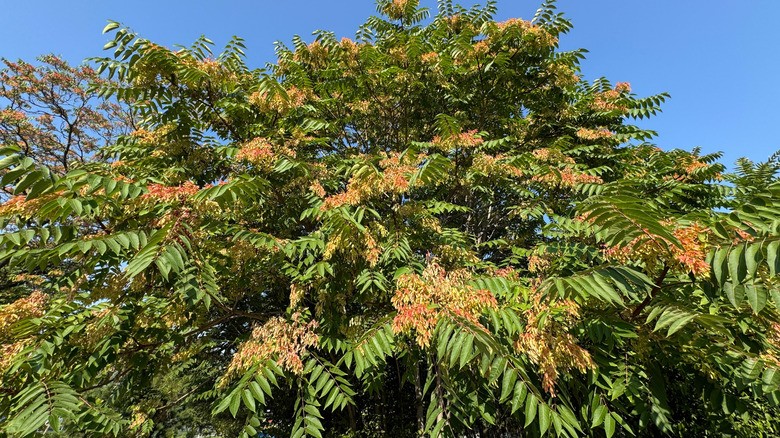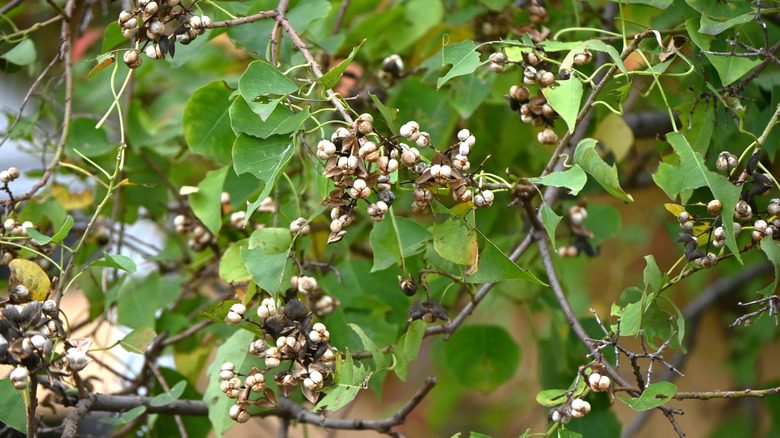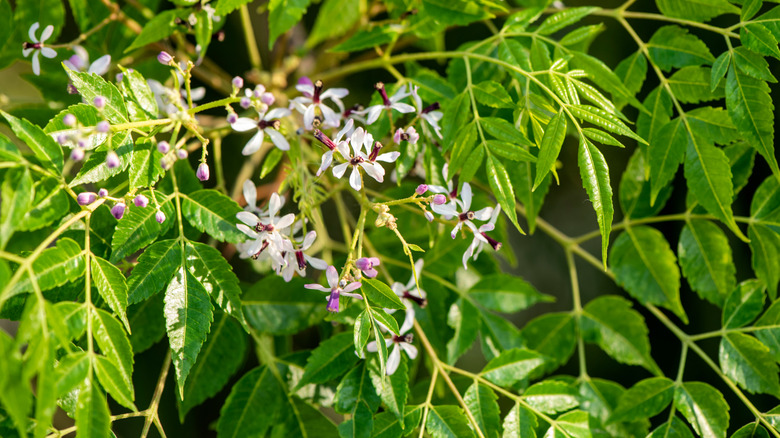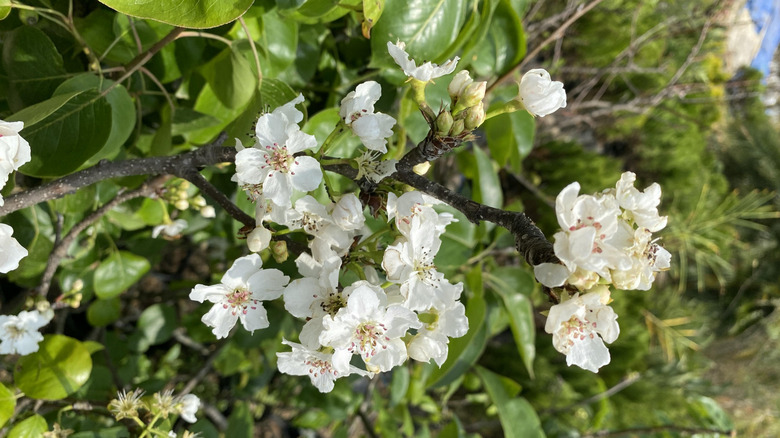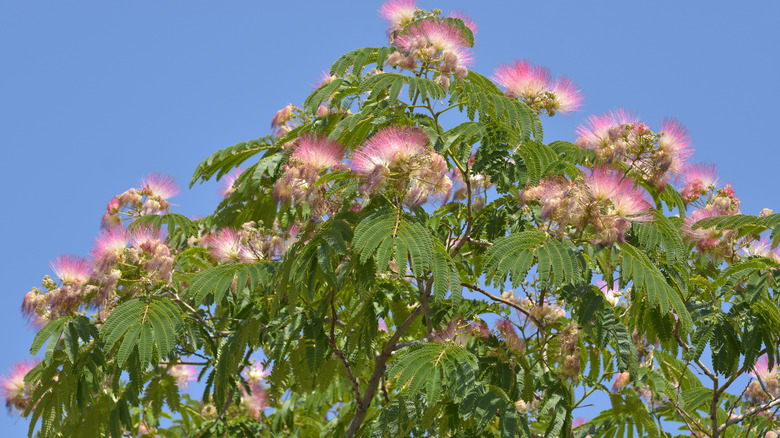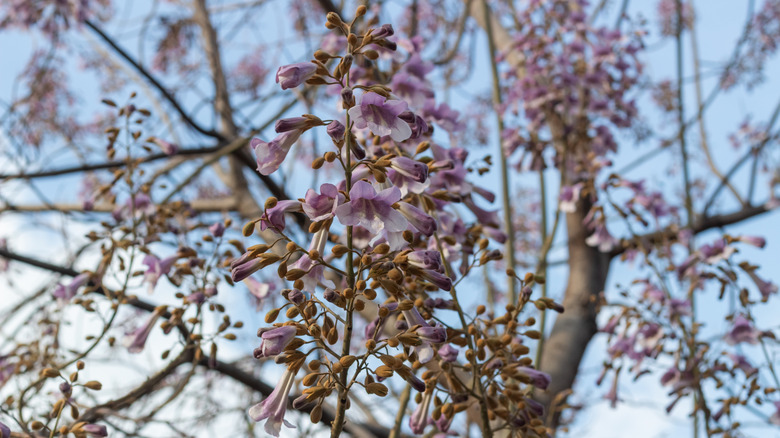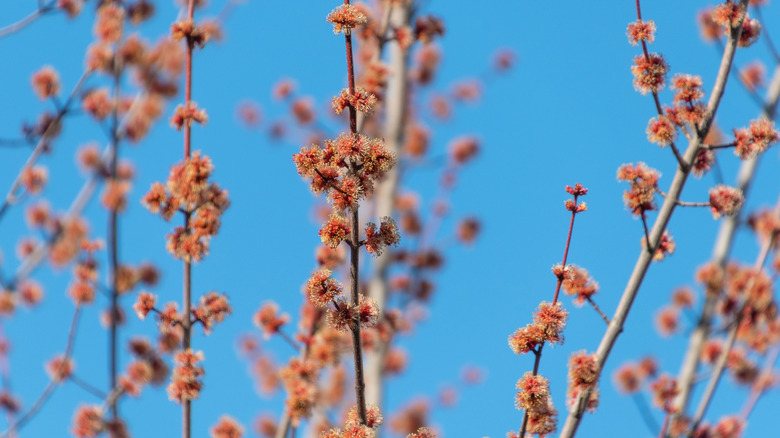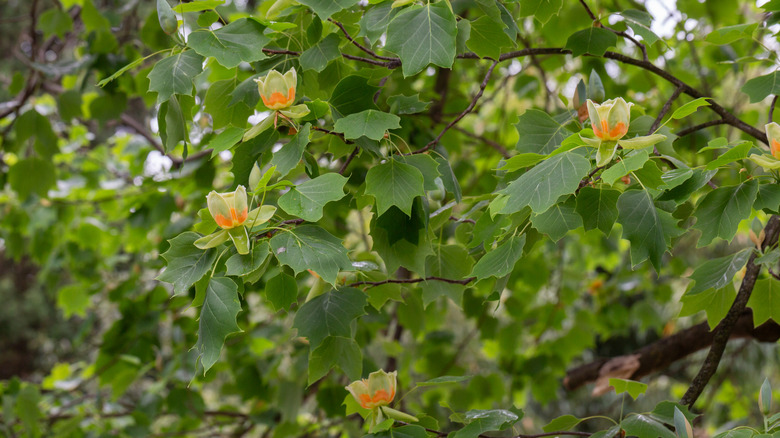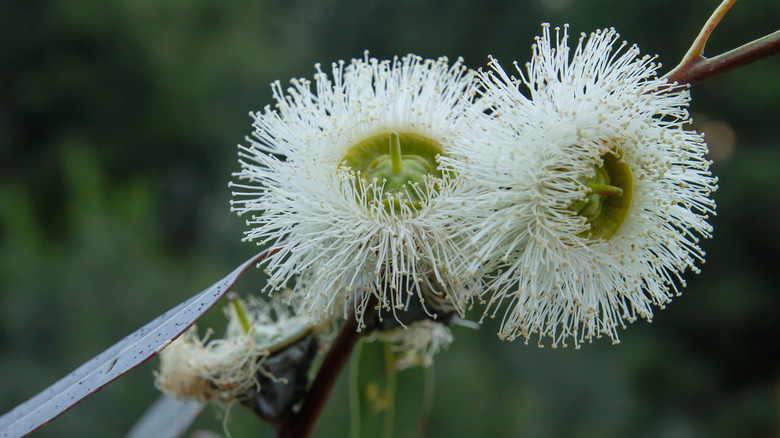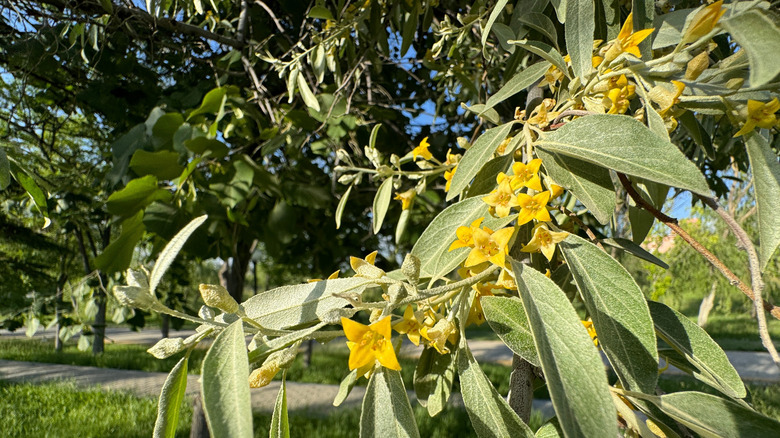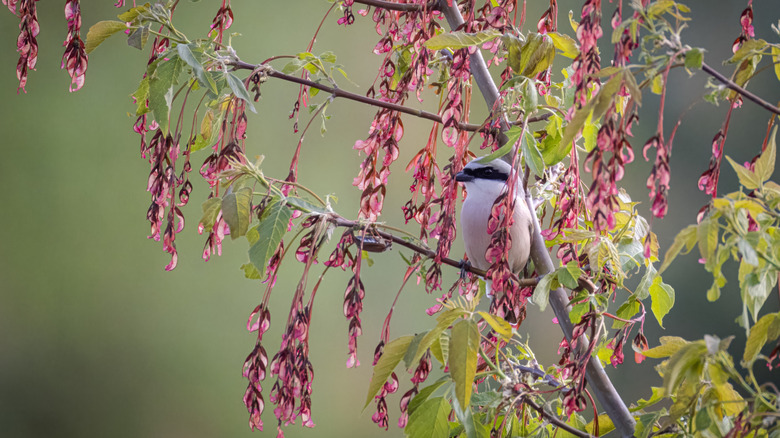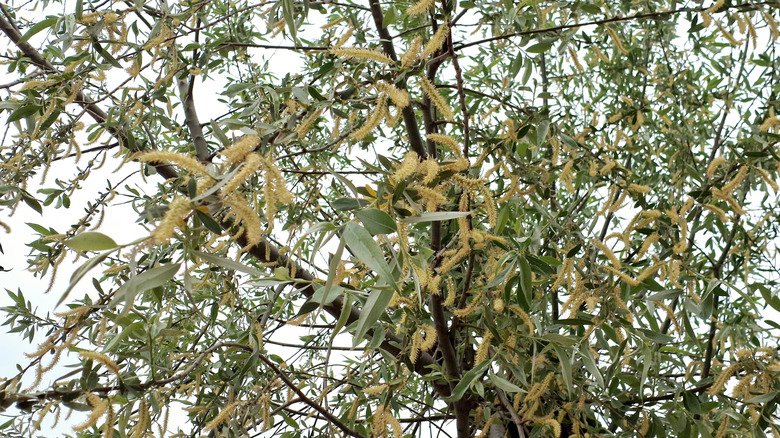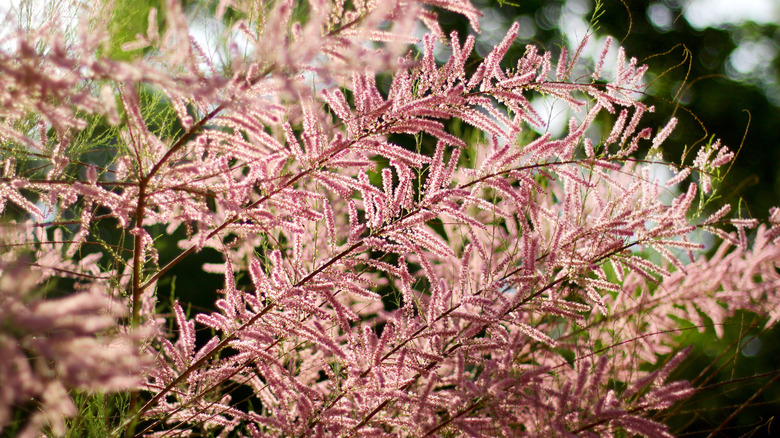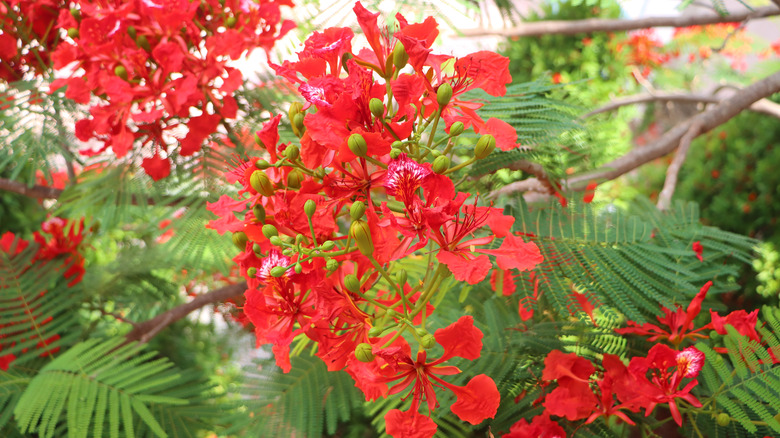16 Fast-Growing Flowering Trees That Aren't Worth Putting In Your Yard
It may seem like fast-growing trees can be the answer to most of your landscaping problems. Who wouldn't want extra shade, colorful blooms, and a wildlife hot spot that doesn't take decades to mature? Unfortunately, that quick growth often comes with issues, especially if you go with non-natives. When we think of weeds, trees aren't usually what comes to mind. However, even some popular tree species can have aggressive roots that can damage your property or take over your garden or neighboring habitats.
Not all fast-growing trees are mistakes, and there are plenty of speedy growers that will do well in your yard without disrupting the local ecosystem. Unfortunately, choosing the wrong species can result in costly repairs, non-stop messes, and crowding out your favorite plants. Despite their many problems when planted in a yard, many of the trees below are still sold online or stocked at garden centers for anyone interested. So before you grab a shovel and start planting, make sure you're not bringing home one of these high-maintenance nightmares.
Golden rain tree
At first glance, the golden rain tree (Koelreuteria paniculata) seems like an absolute dream. In summer, its rounded crown bursts into a cascade of golden-yellow blooms, each dangling in long, graceful panicles for a truly breathtaking display. Although beautiful, there are some major downsides to having a golden rain tree in your yard. This fast-growing tree is considered invasive in many regions due to its aggressive self-seeding habit and tendency to escape cultivation. Plus, its brittle wood makes it downright messy, especially during storms or winter months.
Black locust
While native plants such as black locust (Robinia pseudoacacia) may support pollinators, growing these trees to attract hummingbirds is a big mistake. Its wisteria-like flowers are no doubt gorgeous, but don't let the looks fool you; this tree spreads fast and quickly takes over nearby habitats. Despite being native to several states, its aggressive spread has led it to be considered invasive in states like California, Connecticut, and Michigan. Additionally, all parts of the plant are toxic to humans and pets if ingested. If that weren't enough, it's also notoriously messy, littering yards with thorns and brittle branches.
Tree-of-heaven
Unfortunately, the tree-of-heaven (Ailanthus altissima) is anything but. While it was initially valued for its fast growth and ability to thrive even in poor conditions, those traits are what allowed it to spread across the U.S. rapidly. Now, this Chinese native is listed as an invasive species in dozens of states. Plus, it has an aggressive root system that can be extremely destructive, cracking pavement, damaging foundations, and growing into sewer pipes. Even without the invasive spread, this tree would still be a mistake because of the foul odor that its blooms emit.
Chinese tallow tree
Sometimes referred to as popcorn tree because of its popcorn-like seeds, the Chinese tallow tree (Triadica sebifera) is another invasive plant you should never grow, especially if you live in southeastern states. Introduced to the U.S. in the 1700s, it became popular in the early 1900s for its oil-rich seeds. Like other fast-spreading non-natives, this tree thrives in poor conditions and can quickly take over if not controlled. While the fall foliage is beautiful, it's also damaging. As the leaves break down, they pollute wetlands and pose a serious threat to frogs and other semi-aquatic species.
Chinaberry
With its pretty pink or purple, chocolate-scented flower clusters, it's not too surprising that chinaberry (Melia azedarach) was a popular ornamental plant for centuries. It makes a beautiful shade tree, thrives in a range of conditions, and is virtually disease-free, so what's not to love? Unfortunately, it's the seemingly good qualities that make it an invasive threat in many states. These trees spread quickly by sending up multiple root sprouts, forming dense thickets that displace native species. Even worse, the fruit is toxic to humans and other mammals, making it especially dangerous to have around curious kids or pets.
Bradford pear
The Bradford pear (Pyrus calleryana) is the worst tree to plant in your midwestern yard for several reasons. Despite being popular since the 1960s for its resilience and ornamental appeal, it's listed as an invasive species across several states and banned for sale in at least two. Additionally, as the limbs continue to grow, they often become too heavy for the tree to support. This causes them to split and fall away from the trunk, especially in high winds. This doesn't just ruin its appearance; it can also pose a serious risk to nearby structures.
Persian silk tree
The Persian silk tree (Albizia julibrissin) may look airy and elegant, but it's surprisingly resilient and can handle nearly any soil, light, or water conditions you throw at it. Once the pink, silky flowers fade, the tree produces an abundance of seeds, which are then dispersed by water, wind, or animals, often far from where it was originally planted. In high winds, the seeds can travel upwards of 300 feet. Additionally, the Persian silk tree is short-lived, flammable, and prone to breakage, so it usually causes more trouble than it's worth.
Princess tree
Often considered the fastest-growing tree in the world, the princess tree (Paulownia tomentosa) can grow 15 feet each year. Although the quick growth can offer a sense of instant gratification, this is a beautiful tree you'll regret planting near your home. Not only is it invasive due to its self-seeding habit, but it's also a pain to get rid of. This tree doesn't give up easily and will send up new shoots from its roots several feet away. Plus, it's another species with weak wood, so there's a good chance it'll leave a mess in your yard.
Silver maple
The silver maple (Acer saccharinum) may seem like a harmless native, but it tends to have a few more drawbacks than upsides. Its quick growth, adaptability to most soil types, and tolerance of urban settings made it popular for years. However, as it matures, the problems become hard to ignore. The fruits are messy, it has weak limbs that snap easily in storms or snowy weather, and a shallow root system that pushes up pavement or works its way into drains. While it may be okay in more open areas, it's not the best choice for most yards.
Tulip tree
The tulip tree (Liriodendron tulipifera) is a gorgeous plant with showy green, yellow, or orange cup-shaped blooms, but it's not ideal for most yards. To start, this tree is massive, reaching up to 120 feet tall. Even if your property can accommodate it, this large, fast-growing tree comes with a mess. It produces an abundance of flower petals that will fall to the ground as they fade, and this large tree sheds a massive amount of leaves each year. The wood isn't the strongest either, so the branches will likely break on windy or snowy days.
Blue gum eucalyptus
Blue gum eucalyptus (Eucalyptus globulus) was one of the first Australia-native trees to be introduced to the U.S. and other countries, and now, it's become the most widely planted eucalyptus species across the globe. Because this fast-growing species can reach 98 to 180 feet tall or more, they were valued as windbreakers in California, shielding highways, farmlands, and orange groves in large, open areas. However, it's now recognized as both an invasive species that displaces native plants and a major fire hazard, having contributed to several California wildfires.
Russian olive
With silvery leaves and yellow flowers, the Russian olive (Elaeagnus angustifolia) was introduced to North America in the early 1900s for its ornamental value. Its quick growth and ability to attract birds to the garden were also seemingly beneficial traits, but now this quick-spreading tree has become a major issue. It's an aggressive grower that forms dense, tangled thickets, outcompeting native species like willows and cottonwoods and reducing biodiversity along river corridors. Not only is it notoriously difficult to control, but birds make matters worse by snacking on the berries and spreading the seeds through their droppings.
Boxelder
Another sneakily weedy native, boxelder (Acer negundo), is a type of maple tree that seems like a convenient, fast-growing shade tree but is actually one of the most short-lived and brittle maples you can plant. It's another type of tree with weak wood that makes it prone to decay and branches that will break in stormy or snowy conditions. Boxelders produce a ton of seeds, so if you plant one, there's a chance more will pop up nearby. They're also trees that attract boxelder bugs, which are pesky cousins to stinkbugs and cicadas, often entering buildings in droves.
Willows
Willows (Salix spp.) are popular for their dreamy, graceful appearance, but there are a few things to watch out for if there's a weeping willow in your yard. Non-native willows, like weeping willow (Salix babylonica), are susceptible to a number of disease issues and have aggressive, invasive roots that can outcompete native vegetation for resources. However, even native willows, like black willow (Salix nigra), have roots that actively seek water, damaging pools, sewer lines, and other underground structures. They're another mess-maker in the landscape, constantly shedding leaves and twigs, and their weak branches tend to snap during storms.
Salt cedar
Salt cedar (Tamarix spp.) gets its name from its salt-excreting leaves, along with a cedar-like foliage. Initially introduced to the western U.S. in the 1800s, it's now considered highly invasive, especially in riparian areas. It quickly outcompetes native species, and when the salty leaves fall, they raise soil salinity, making it even harder for native plants to grow. Tamarix wreaks havoc near rivers and streams, with one plant using up to 200 gallons of water, contributing to lowered water tables and reduced stream flow.
Royal poinciana
Royal Poinciana (Delonix regia) is a tree that blooms with gorgeous red flowers, but this exotic beauty is more maintenance than most homeowners bargain for. Once its showy scarlet flowers fade, the 18-inch-long, bean-like fruit pods appear. As the weather warms up, these pods will drop beneath them and leave a blanket of debris to clean up. As if the pods weren't enough, these trees tend to shed entire branches when it gets a bit windy. Although not the most problematic plant, experts recommend careful management to prevent it from spreading outside cultivated landscapes.
